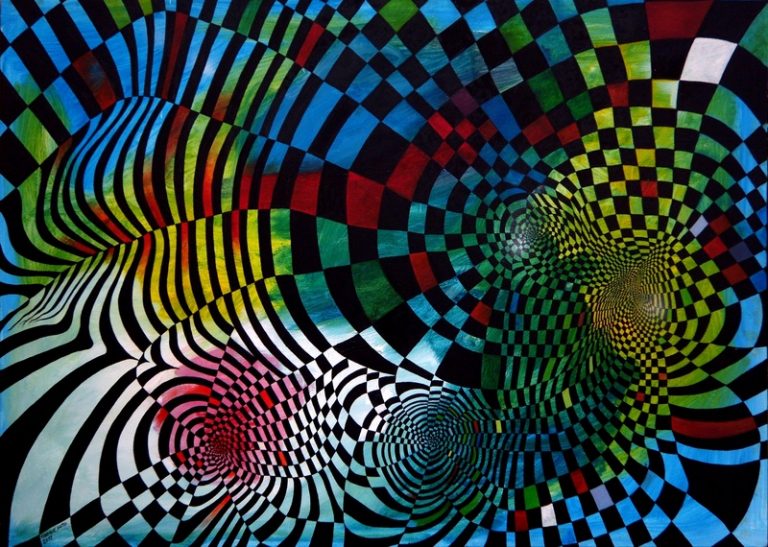XXth century
Optical art

description
Optical art is an art movement of the second half of the twentieth century, based on the peculiarities of the perception of flat and spatial figures through various visual illusions that arise automatically, giving rise to some kind of disturbance inside a person, thereby making us pay attention to the work. It was formed on the basis of geometric abstractionism. The peak of its popularity was in the 1960s and 70s in Europe, the USA and Latin America.
For the first time, the term was used in 1964 by artist Donald Jud in a review of the exhibition “Optical Paintings” by Julian Stanchak.
Optical art became world-famous after the international exhibition The Responsive Eye, which took place in New York in 1965.
The works are divided into two categories: black and white paintings that create the effect of movement (rotation, flicker, vibration) and colour pictures – a specific colour combination or the influence of light on colour, creating an illusory image and ripple. To enhance the effect, masters sometimes used nylon, metal, and glass plastic.
Similar art movements: Kinetic art, Abstractionism. However, in this form of art, unlike Kinetic, work and the viewer are motionless. Op-art artists also experiment with light (flashes, highlighting, moving a light source), dynamic designs (crossing through forms in space, the moving viewer); such works are at the junction with Kinetic art.
The art patterns of the movement were used in advertising, cinema, architecture, graphic design, interior design, household items, discos and clothes.
Key ideas:
– The deception of the eye, which is trying to arrange randomly scattered objects into a simpler holistic system, as a result – disorientation due to the conflict between the actual picture and the illusory-visible. Creating an optical illusion of the motion of a stationary object is carried out through the psychophysiological perception of the viewer. The spatial action of Op art is always virtual.
– Art techniques: linear perspective, the sequence of forms (wave-like, spiral, chess-like, trellised, funnel-shaped, etc.), colour and tonal contrasts (fading or saturation), “moire effect”, dual images, reversible figures.
description
A German artist, designer, writer and theorist of art, a talented teacher who worked in America for a long time. The name of Josef Alberts is inextricably connected with the Bauhaus Higher Art School in Weimar, which was known for its avant-garde orientation. A former student of this institution, Albers worked there as a teacher, created a new art glass studio, and later became the deputy director of the school.In the USA, where the artist emigrated after the Bauhaus was disbanded by the Nazi authorities, he continued his teaching activities and played an important role in spreading the aesthetics of constructivism, cubism and abstract art among American artists. His work served as a kind of bridge between European avant-garde trends and the new modern art of America.Albers was best known for his series of works “Homage to the Square”, which includes geometric abstract paintings and lithographs that are distinguished by exceptionally subtle chromatic harmony. Almost all the paintings in the series consist of several squares that are inside each other and painted in muted harmonious colours. Creating his work, the artist carefully thought out every detail, the most delicate shades of colour and the effect of the use of certain combinations.In 1963, the artist developed the theory of colour pigments, which he outlined in his book “Interaction of Colour”.
1888 - 1976
description
Henri-Robert-Marcel Duchamp was a French and American artist, an art theorist, one of the founders of such art movements as Dadaism and Surrealism.Was born into a wealthy family. His mother, brothers and sister were engaged in painting, and Marcel grew up in a creative atmosphere, which contributed to the early manifestation of his talent. Following the older brothers, he began to paint in the style of impressionism, presenting quite interesting works from the age of 14.Marcel Duchamp, despite a small number of his works, was one of the most influential figures of fine art after the First World War, a genius and a rebel, who pushed the scope of painting beyond what was permitted. The artist was the author of the "ready-made" method, being the first to use the idea of creating art objects from the most common objects, such as a bicycle wheel and even a urinal. The unusual and sometimes shocking creativity of Duchamp has opened wide opportunities for the further development of avant-garde art all over the world.At the end of his career, the artist departed from painting, preferring to use already finished objects for his works, which he called "ready-made", or creating voluminous collages. In addition to his artistic creativity, Marcel Duchamp starred in films, wrote articles and studied chess, in which he was a professional. Thanks to his versatile and unordinary talent, he left a bright mark in the art of the early twentieth century and laid the foundation for the emergence of completely new methods and trends in painting.
1887 - 1968
description
Spanish painter, graphic artist, sculptor, director and writer. One of the most famous figures in Surrealism, and author of “The Persistence of Memory”, one of the most famous paintings of the 20th century.Dalí started painting at the age of four. He created his first serious work at the age of ten. It was a small impressionistic landscape, painted on a wooden board with oil paints. Henceforth, Dali spent whole days sitting in a small, specially allocated room and painting pictures. “I wanted to be given the laundry under the roof of our house. I got it and made it my own workshop, decorating it in the way I preferred,” he remembered later. Moreover, he liked to analyze the works of famous artists. He wrote and published essays about the works of Velazquez, Goya, El Greco, Michelangelo and Leonardo da Vinci.
1904 - 1989
